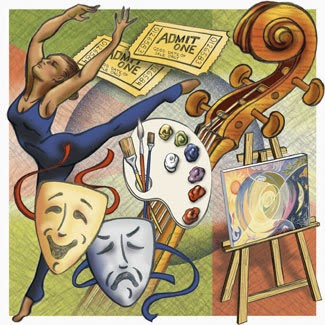Art has always been a part of
our history. The first tangible artifacts of human art are found from the Stone
Age (Upper Paleolithic, Mesolithic and Neolithic). During the Paleolithic (25
000-8000 BCE), man practiced hunting and lived in caves, where cave painting
was developed. That method was also believed to be a form of communication. Art
continued to change and evolve as time progressed. Early civilizations such as
the Ancient Egyptians, the Ancient Chinese and the Mayans introduced a whole
new world of art that changed history. For example, the Ancient Egyptians arose
as one of the first great civilizations, with elaborate and complex works of
art, which assume the professional specialization of the artist/craftsman. Its
art was intensely religious and symbolic, with a highly centralized power
structure and hierarchy, giving great importance to the religious concept of
immortality, especially of the pharaoh, for whom were built great monuments. Other
civilizations contributed into the evolution of art as well. They paved the way
for the development of different branches of art such as music, literature and architecture
that established different cultures.
Art has changed and transformed throughout the years.
In modern times, art has expanded further into different forms including music,
dance and visual arts. Music is the vocal or instrumental sounds combined in
such a way as to produce beauty of form, harmony, and expression of emotion. Today,
music is divided into various genres like pop, rock, classical, R&B and
hip-hop. Dancing is the rhythmical movement to music, using steps and gestures.
Early forms of dancing were used for religious offerings, celebrations,
rituals. Today, dancing is mostly used for entertainment purposes which lead to
the creation of different types of dance e.g. ballet, disco, street dance.
Visual arts are produced mainly for visual perception and enjoyment as well as
for intellectual purposes. It applies to both the fine arts (painting, sculpture,
photography, etc.) and the applied arts (industrial, graphic, interior and
fashion designs). As we can see, the concept of art is no longer traditional
and it continues to change as people find new discoveries and meanings about
art.
Art is closely connected with history because it helped
shape the traditional roots of our cultures and gave them a distinct identity. In
the future, I think art will be a lot different from what is now. It will be
transformed into digital form. Everyone will be able to view and create art
with the use of advanced technologies like those in science fiction movies. Art
has no boundaries; it is only limited by our imaginations. I’m really looking
forward to the time when mankind will bring forth a new kind of art. I would also
like to thank our ancestors, whom without; we would not have known the
wonderful gift that is “Art”.
References:
Perez, V. History/timeline of
dance 1900 – 2012. (2012, November 28). Prezi.com.
Retrieved November 16, 2014, from https://prezi.com/nqqs1oqn4v34/historytimeline-of-dance-1900-2012/
Fine art. (n.d.). In Wikipedia, The Free Encyclopedia.
Retrieved November 16, 2014 from http://en.wikipedia.org/wiki/Fine_art
Visual arts. (n.d.). In
Wikipedia, The Free Encyclopedia. Retrieved November 16, 2014 from http://en.wikipedia.org/wiki/Visual_arts
History of art. (n.d.). In
Wikipedia, The Free Encyclopedia.
Retrieved November 16, 2014 from http://en.wikipedia.org/wiki/History_of_art
Images from:
http://stockarch.com/images/business-and-industry/art-design/art-2082
http://alpha.sd41.bc.ca/static.php?page=static110110-204537
http://img.gawkerassets.com/img/17vzt2aabxn07jpg/original.jpg



No comments:
Post a Comment